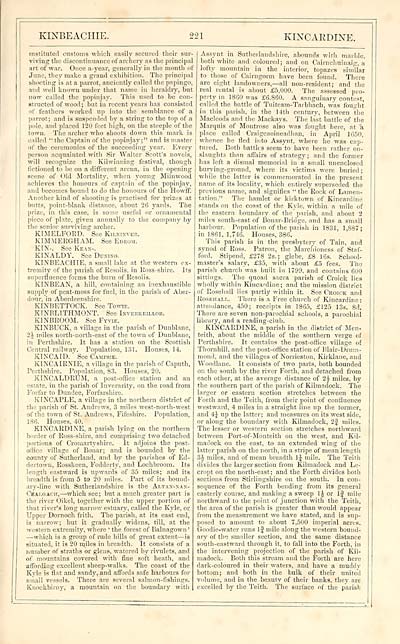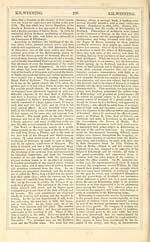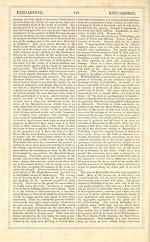Download files
Complete book:
Individual page:
Thumbnail gallery: Grid view | List view

KINBEACHIE.
221
KINCARDINE.
instituted customs which easily secured their sur-
viving the discontinuance of archery as the principal
art of war. Once a-year, generally in the month of
June, they make a grand exhibition. The principal
shooting is at a parrot, anciently called the papingo,
and well known under that name in heraldry, but
now called the popinjay. This used to be con-
structed of wood; but in recent years has consisted
nt' feathers worked up into the semblance of a
parrot; and is suspended by a string to the top of a
pole, and placed 120 feet high, on the steeple of the
town. The archer who shoots down this mark is
called " the Captain of the popinjay;" and is master
of the ceremonies of the succeeding year. Every
person acquainted with Sir Walter Scott's novels,
will recognize the Kilwinning festival, though
tictioned to be on a different arena, in the opening
scene of ( )ld Mortality, when young Milnwood
achieves the honours of captain of the popinjay,
and becomes bound to do the honours of the Howff.
Another kind of shooting is practised for prizes at
butts, point-blank distance, about 26 yards. The
prize, in this case, is some useful or ornamental
piece of plate, given annually to the companv by
the senior surviving archer.
KIMELFORD. "See Kilxixveis.
KIMMERGHAM. See Edrom.
KIN-. See Keax-.
KINALDY. See Duxixo.
KINBEACHIE, a small lake at the western ex-
tremity of the parish of Resolis. in Ross-shire. Its
superfluence forms the burn of Resolis.
KINBEAN, a hill, containing an inexhaustible
supply of peat-moss for fuel, in the parish of Aber-
dour, in Aberdeenshire.
KINBETTOCK. See Towte.
KTNBL1THMONT. See Invekkeillor.
KINBROOM. See Fvvie.
KINBUCK, a village in the parish of Dunblane,
2J miles north-north-east of the town of Dunblane,
in Perthshire. It has a station on the Scottish
Central railway. Population, 131. Houses, 14.
KINCAID. ' See Camps™.
KINCAIRNIE, a village in the parish of Caputh,
Perthshire. Population, 8.3. Houses, 20.
KINCALDRUM, a post-office station and an
estate, in the parish of Inverarity, on the road from
Forfar to Dundee, Forfarshire.
KINCAPLE, a village in the northern district of
the parish of St. Andrews, 3 miles west-north-west
of the town of St. Andrews, Fifeshire. Population,
186. Houses, 40.
KINCARDINE, a parish lying on the northern
border of Ross-shire, and comprising two detached
portions of Cromartyshire. It adjoins the post-
office village of Bonar; and is bounded by the
county of Sutherland, and by the parishes of Ed-
dertown, Rosskeen, Fodderty, and Lochbroom. Its
length eastward is upwards of 35 miles; and its
breadth is from 5 to 20 miles. Part of its bound-
ary-line with Sutherlandshire is the Aetax-xax-
Cealgach, — which see; but a much greater part is
the river Oikel, together with the upper portion of
that river's long narrow estuary, called the Kyle, or
Upper Dornoch frith. The parish, at its east end,
is narrow; but it gradually widens, till, at the
western extremity, where ' the forest of Balnagown '
— which is a group of rude bills of great extent — is
Bituated, it is 20 utiles in breadth. It consists of a
number of straths or glens, watered by rivulets, and
of mountains covered with fine soft heath, and
affording excellent sheep-walks. The coast of the
Kyle is flat and sandy, and affords safe harbours for
small vessels. There are several salmon-fishings.
Knockbirny, a mountain on the boundary with
Assynt in Sutherlandshire, abounds with marble,
both white and coloured; and on Cairnchuinaig, a
lofty mountain in the interior, topazes similar
to thpse of Cairngorm have been found. There
are eight landowners, — all non-resident; and the
real rental is about £5,000. The assessed pro-
perty in 1860 was £6.860. A sanguinary contest,
called the battle of Tuiteam-Tarbbach, was fought
in tins parish, in the 14th century, between the
Macleods and the Mackays. The last battle of the
Marquis of Montrose also was fought here, at a
place called Craigcaoineadhan, in April 1650,
whence he fled into Assynt, where he was cap-
tured. Both battles seem to have been rather on-
slaughts than affairs of strategy; and the former
has left a dismal memorial in a small unenclosed
burying-ground, where its victims were buried ;
while the latter is commemorated in the present
name, of its locality, which entirely superseded the
previous name, and signifies " the Rock of Lamen-
tation." The hamlet or kirktown of Kincardine
stands on the coast of the Kyle, within a mile of
the eastern boundary of the parish, and about 2
miles south-east of Bonar-Bridge. and has a small
harbour. Population of the parish in 1831, 1,887;
in 1861, 1,746. Houses, 386.
This parish is in the presbytery of Tain, and
synod of Ross. Patron, the Marchioness of Staf-
ford. Stipend, £278 2s. _; glebe, £8 16s. School-
master's salary, £35, with about £5 fees. The
parish church was built in 1799, and contains 600
sittings. The quoad sacra parish of Croick lies
wholly within Kincardine; and the mission district
of Rosehall lies partly within it. See Croick and
Rosehai.l. There is a Free church of Kincardine:
attendance, 450; receipts in 1865, £125 13s. 8d.
There are seven non-parochial schools, a parochial
library, and a reading-clnb.
KINCARDINE, a parish in the district of Men-
teith, about the middle of the southern verge of
Perthshire. It contains the post-office village of
Thomhill. and the post-office station of Blair-Druin-
mond, and the villages of Norrieston, Kirklaue, and
Woodbine. It consists of two parts, both hounded
on the south by the river Forth, and detached from
each other, at the average distance of 2A miles, by
the southern part of the parish of Kilmadock. The
larger or eastern section stretches between the
Forth and the Teith, from their point of confluence
westward, 4 miles in a straight line up the former,
and 4J up the latter; and measures on its west side,
or along the boundary with Kilmadock, 2f miles.
The lesser or western section stretches northward
between Port-of-Monteith on the west, and Kil-
madock on the east, to an extended wing of the
latter parish on the north, in a stripe of mean length
3J miles, and of mean breadth 1J mile. The Teith
divides the larger section from Kilmadock and Le-
cropt on the north-east; and the Forth divides both
sections from Stirlingshire on the south. In con-
sequence of the Forth bending from its general
easterly course, and making a sweep 1A or If mile
northward to the point of junction with the Teith,
the area of the parish is greater than would appear
from the measurement we have stated, and is sup-
posed to amount to about 7,500 imperial acres.
Goodie-water runs If mile along the western bound-
ary of the smaller section, and the same distance
south-eastward through it, to fall into the Forth, in
the intervening projection of the parish of Kil-
madock. Both this stream and the Forth are here
dark-coloured in their waters, and have a muddv
bottom; and both in the bulk of their united
volume, and in the beauty of their banks, they are
excelled by the Teith. The surface of the parish
221
KINCARDINE.
instituted customs which easily secured their sur-
viving the discontinuance of archery as the principal
art of war. Once a-year, generally in the month of
June, they make a grand exhibition. The principal
shooting is at a parrot, anciently called the papingo,
and well known under that name in heraldry, but
now called the popinjay. This used to be con-
structed of wood; but in recent years has consisted
nt' feathers worked up into the semblance of a
parrot; and is suspended by a string to the top of a
pole, and placed 120 feet high, on the steeple of the
town. The archer who shoots down this mark is
called " the Captain of the popinjay;" and is master
of the ceremonies of the succeeding year. Every
person acquainted with Sir Walter Scott's novels,
will recognize the Kilwinning festival, though
tictioned to be on a different arena, in the opening
scene of ( )ld Mortality, when young Milnwood
achieves the honours of captain of the popinjay,
and becomes bound to do the honours of the Howff.
Another kind of shooting is practised for prizes at
butts, point-blank distance, about 26 yards. The
prize, in this case, is some useful or ornamental
piece of plate, given annually to the companv by
the senior surviving archer.
KIMELFORD. "See Kilxixveis.
KIMMERGHAM. See Edrom.
KIN-. See Keax-.
KINALDY. See Duxixo.
KINBEACHIE, a small lake at the western ex-
tremity of the parish of Resolis. in Ross-shire. Its
superfluence forms the burn of Resolis.
KINBEAN, a hill, containing an inexhaustible
supply of peat-moss for fuel, in the parish of Aber-
dour, in Aberdeenshire.
KINBETTOCK. See Towte.
KTNBL1THMONT. See Invekkeillor.
KINBROOM. See Fvvie.
KINBUCK, a village in the parish of Dunblane,
2J miles north-north-east of the town of Dunblane,
in Perthshire. It has a station on the Scottish
Central railway. Population, 131. Houses, 14.
KINCAID. ' See Camps™.
KINCAIRNIE, a village in the parish of Caputh,
Perthshire. Population, 8.3. Houses, 20.
KINCALDRUM, a post-office station and an
estate, in the parish of Inverarity, on the road from
Forfar to Dundee, Forfarshire.
KINCAPLE, a village in the northern district of
the parish of St. Andrews, 3 miles west-north-west
of the town of St. Andrews, Fifeshire. Population,
186. Houses, 40.
KINCARDINE, a parish lying on the northern
border of Ross-shire, and comprising two detached
portions of Cromartyshire. It adjoins the post-
office village of Bonar; and is bounded by the
county of Sutherland, and by the parishes of Ed-
dertown, Rosskeen, Fodderty, and Lochbroom. Its
length eastward is upwards of 35 miles; and its
breadth is from 5 to 20 miles. Part of its bound-
ary-line with Sutherlandshire is the Aetax-xax-
Cealgach, — which see; but a much greater part is
the river Oikel, together with the upper portion of
that river's long narrow estuary, called the Kyle, or
Upper Dornoch frith. The parish, at its east end,
is narrow; but it gradually widens, till, at the
western extremity, where ' the forest of Balnagown '
— which is a group of rude bills of great extent — is
Bituated, it is 20 utiles in breadth. It consists of a
number of straths or glens, watered by rivulets, and
of mountains covered with fine soft heath, and
affording excellent sheep-walks. The coast of the
Kyle is flat and sandy, and affords safe harbours for
small vessels. There are several salmon-fishings.
Knockbirny, a mountain on the boundary with
Assynt in Sutherlandshire, abounds with marble,
both white and coloured; and on Cairnchuinaig, a
lofty mountain in the interior, topazes similar
to thpse of Cairngorm have been found. There
are eight landowners, — all non-resident; and the
real rental is about £5,000. The assessed pro-
perty in 1860 was £6.860. A sanguinary contest,
called the battle of Tuiteam-Tarbbach, was fought
in tins parish, in the 14th century, between the
Macleods and the Mackays. The last battle of the
Marquis of Montrose also was fought here, at a
place called Craigcaoineadhan, in April 1650,
whence he fled into Assynt, where he was cap-
tured. Both battles seem to have been rather on-
slaughts than affairs of strategy; and the former
has left a dismal memorial in a small unenclosed
burying-ground, where its victims were buried ;
while the latter is commemorated in the present
name, of its locality, which entirely superseded the
previous name, and signifies " the Rock of Lamen-
tation." The hamlet or kirktown of Kincardine
stands on the coast of the Kyle, within a mile of
the eastern boundary of the parish, and about 2
miles south-east of Bonar-Bridge. and has a small
harbour. Population of the parish in 1831, 1,887;
in 1861, 1,746. Houses, 386.
This parish is in the presbytery of Tain, and
synod of Ross. Patron, the Marchioness of Staf-
ford. Stipend, £278 2s. _; glebe, £8 16s. School-
master's salary, £35, with about £5 fees. The
parish church was built in 1799, and contains 600
sittings. The quoad sacra parish of Croick lies
wholly within Kincardine; and the mission district
of Rosehall lies partly within it. See Croick and
Rosehai.l. There is a Free church of Kincardine:
attendance, 450; receipts in 1865, £125 13s. 8d.
There are seven non-parochial schools, a parochial
library, and a reading-clnb.
KINCARDINE, a parish in the district of Men-
teith, about the middle of the southern verge of
Perthshire. It contains the post-office village of
Thomhill. and the post-office station of Blair-Druin-
mond, and the villages of Norrieston, Kirklaue, and
Woodbine. It consists of two parts, both hounded
on the south by the river Forth, and detached from
each other, at the average distance of 2A miles, by
the southern part of the parish of Kilmadock. The
larger or eastern section stretches between the
Forth and the Teith, from their point of confluence
westward, 4 miles in a straight line up the former,
and 4J up the latter; and measures on its west side,
or along the boundary with Kilmadock, 2f miles.
The lesser or western section stretches northward
between Port-of-Monteith on the west, and Kil-
madock on the east, to an extended wing of the
latter parish on the north, in a stripe of mean length
3J miles, and of mean breadth 1J mile. The Teith
divides the larger section from Kilmadock and Le-
cropt on the north-east; and the Forth divides both
sections from Stirlingshire on the south. In con-
sequence of the Forth bending from its general
easterly course, and making a sweep 1A or If mile
northward to the point of junction with the Teith,
the area of the parish is greater than would appear
from the measurement we have stated, and is sup-
posed to amount to about 7,500 imperial acres.
Goodie-water runs If mile along the western bound-
ary of the smaller section, and the same distance
south-eastward through it, to fall into the Forth, in
the intervening projection of the parish of Kil-
madock. Both this stream and the Forth are here
dark-coloured in their waters, and have a muddv
bottom; and both in the bulk of their united
volume, and in the beauty of their banks, they are
excelled by the Teith. The surface of the parish
Set display mode to: Large image | Transcription
Images and transcriptions on this page, including medium image downloads, may be used under the Creative Commons Attribution 4.0 International Licence unless otherwise stated. ![]()
| Gazetteers of Scotland, 1803-1901 > Imperial gazeteer of Scotland, or, Dictionary of Scottish topography > Volume 2 > (241) Page 221 |
|---|
| Permanent URL | https://digital.nls.uk/97473570 |
|---|
| Attribution and copyright: |
|
|---|---|

